Barks Blog
Tips to Help Your Reactive Dog
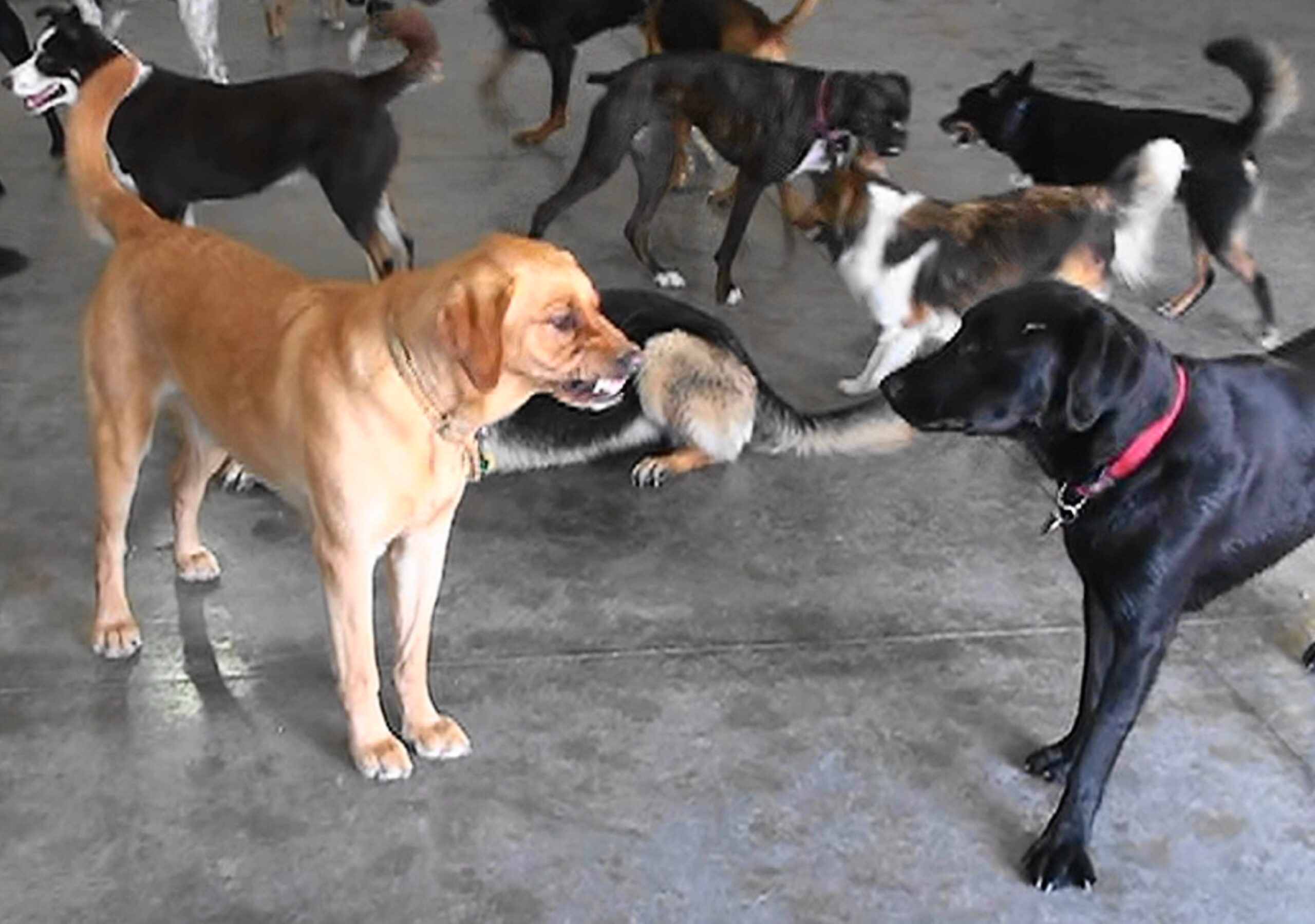
As a certified canine behavior consultant I enjoy working with “reactive” dogs. Yes, I said enjoy. Helping a dog and their guardian overcome this common behavioral issue is truly joyful for everyone involved.
This is a long post…entire books have been written on this topic after all.
I want to give you some virtual help during the global pandemic which has us sheltering at home. So feel free to get a cup of coffee or tea and then continue reading.
What “reactive” means
This refers to canine behavior in which a dog is over-aroused by something in the environment. For some dogs it may be the sight of another dog, a child riding a bike, a jogger passing by the window or any number of things.
The behavior response includes an abrupt increase in tension and arousal, repeated barking, lunging, a threatening tooth display or other behaviors which guardians often perceive as aggressive.
A geeky explanation is that environmental stimuli trigger the HPA-axis in which the amygdala and limbic system drive reactive, emotional behavior out of proportion to the situation, referred to as amygdala hijack. It is simpler to call it reactivity so I will use that non-scientific term.
The next thing to understand is the emotional motivation of the behavior. Behaviorists tell us that emotion underlies behavior, and that behavior is in the environment. A dog’s behavior is neither right or wrong; it is a response to something which appears, and when that “something” goes away the behavior changes back.
Most reactive dogs are motivated by fear or frustration
Fearful dogs display agonistic (distance-increasing) behaviors in an attempt to make the scary thing go away. Visualize a dog who perches as the front window all day long, waiting for the next scary thing to appear, such as a postal worker. The dog sees the person approaching and goes into a barking frenzy, bouncing off the window pane as spittle flies hither and yon.
That was how one of my client’s dogs behaved, until we successfully completed a force-free training and behavior modification program. The emotional motivation was fear and the dog was probably trying to make the scary postal worker go away…which the postal worker did. Indeed, it worked every time.
Of course that would have happened in spite of the dog’s behavior, but it reinforced the behavior nonetheless because departure of the person reduced pressure, so the dog then felt better.
Another dog may be a young and over-eager greeter who sees another dog during a walk, becomes excited and rushes to say hello…but is foiled by the leash. A neuroscientist may explain that the eager-greeter’s seeking system was engaged and the dog rushed forward with the expectation of playing with the other dog.
With enough repetition of that process the friendly dog may become frustrated, which leads to anger and an emotional outburst, and the physical behaviors I previously described. Daily walks become an exercise in frustration for both the dog and the human handler. Most reactive dogs I have worked with fall into that category.
What pet guardians can do
People often seek advice from those they know and trust such as friends, coworkers and relatives…most of whom are probably not professional dog trainers. The guardian may hear suggestions of using equipment to “control” the dog and thus focus on behavior, rather than the underlying emotion.
Many of my Project Trade acquisitions have come from clients who used aversive equipment which, by design, caused discomfort and pain, with intent to suppress the dog’s unwanted behavior. They swapped their gear with me in return for a discount, as I taught them force-free alternatives.
Research has shown the use of aversive equipment affords no advantages over force-free methods, but does create animal welfare problems such as increased anxiety, fear or aggressive behavior. (Ziv, 2017) Such methods and equipment also fail to address the underlying motivation of the behavior.
I recommend consulting a modern science-based and force-free trainer. There are several well-established protocols which have proven effective in resolving reactive behavior in ways which address the underlying cause, strengthen the canine-human relationship and enable dogs and guardians to enjoy their walks together.
The Pet Professional Guild has a free online search tool to help guardians find qualified dog trainers within their geographic area. All PPG professional members have agreed to only use force-free methods so you can be confident that you will get the help you need, without any risk to your beloved dog’s welfare.
Some pet guardians may not be able to use the services of a trainer during the COVID-19 pandemic, so the rest of this article has practical tips for pet guardians, citing examples of dogs I worked with.
General guidelines
- Address the emotional motivation of the reactivity.
- Instead of focusing on what you do not want your dog to do, think of all the things you do want him to do. I suggest teaching your dog to make eye contact on cue, pay for close proximity, and teach an automatic sit as a default behavior when you stop moving. You will have a dog who stays within reach and pays close attention to you rather than looking for things in the environment to worry about.
- Be very generous with food delivery in the beginning, develop habitual behaviors, and then reduce food delivery to a random basis. Imagine that you are a vending machine and your dog puts a coin in the slot. He expects to get his snack each time so do not disappoint him, and use especially enticing foods. Once you see your dog offering favorable behaviors habitually, switch to slot machine mode and pay him every now and then. That is the best way to maintain a behavior.
- Think in terms of response prevention, rather than redirecting. If your goal is to enjoy nice walks with your dog then focus on preventing reactive outbursts by catching your dog doing the things you prefer, and let him know how much you appreciate it. If you see one of your dog’s triggers in the environment, begin engaging him while he is still calm.
- If you wait for your dog to engage in reactive behavior and then try to redirect him, you have missed an opportunity and enabled the unwanted behavior to be rehearsed. Behaviors which repeat grow stronger as the neural pathways deepen. Once your dog is in a reactive state he may no longer respond to training cues or take food. It is like paddling a canoe down a river, approaching a waterfall. If you wait until the canoe is tipping over the edge, it is too late to redirect it to the shore. Steer your canoe to safety before the (amygdala) current takes control.
- When you encounter a known stress trigger, stop and work with your dog. If he is unable to respond to you, move further away and try again. Find the sweet spot where your dog is aware of the trigger and then looks back at you. Pay him for doing so! He will learn how to cope with environmental triggers as new neural pathways develop, with calmer behavioral responses.
- Make every walk a fun and interesting experience for your dog. All him to sniff about and investigate the environment and to make choices. Doing so produces dopamine and has a calming affect.
- In extreme cases a fearful dog may need the support of behavioral pharmacology, in conjunction with an applied animal behavior analysis and training/behavior modification plan.
Ranger
The first reactive dog I worked with was a beautiful two-year old Australian Shepherd. He was extremely fearful, reactive to many triggers and had separation anxiety. Taking him for a walk was nearly impossible for his foster family. Ranger was going to be euthanized due to his poor quality of life.
He was very frightened of me at first so earning his trust was a priority. Then I taught him some basic but useful skills: Look, Touch, Find It. These gave me ways for us to interact and bond safely within the home, and then I had tools to use during walks to engage him in fun games when we went outside.
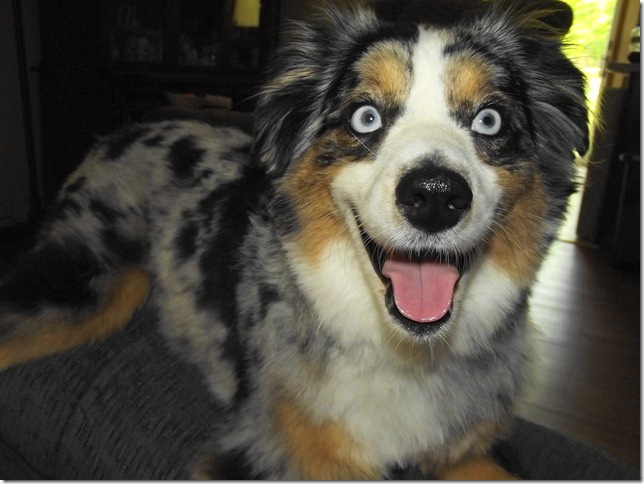
I wrote a list of every fear trigger and systematically desensitized and counter-conditioned them, one by one. We also worked on his separation anxiety, eventually resolving it. Ranger’s world systematically became less threatening and more predictable.
Ranger went from a doomed dog to a confident and happy-go-lucky youngster, who was successfully adopted. It took about three months of effort, so if you live with a fearful dog please be patient and stay the course. You and your dog will be richly rewarded in the end.
Rocket
I had the joy of teaching this Welsh Terrier as an 8-week old puppy and watched him grow into adolescence over two years. True to his Terrier heritage every squirrel or bunny he saw during a walk triggered his seeking system and a predatory response, bolting like a rocket toward his target. The family appropriately nicknamed him Rocket Man.
Rocket developed poor leash manners in his teenage development, yanking on the leash so much that his poor guardian developed sore knees and could only walk him two blocks at a time. He was a very social boy and wanted to run up to and greet every dog along the way, leading to more bolting on the leash, increasing frustration, and reactive behavior.
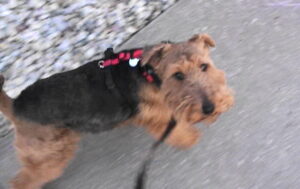
It was easy working with Rocket since he had a solid training foundation and we enjoyed a close relationship. I paid him generously with treats like beef, pork and cheese during our walks. His job was to walk beside me with a loose leash, offer frequent eye contact and to sit whenever I stopped walking. Rocket became such a great leash walker I featured him in a training video.
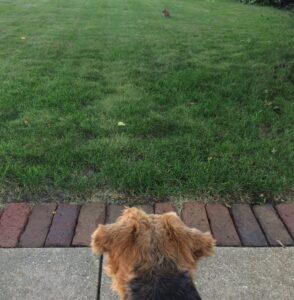
Bunnies, squirrels and dogs were Rocket’s main triggers. I developed a habit of scanning for them during our walks and had food at the ready. If Rocket saw a bunny in a yard I stopped and let Rocket watch the bunny. When he looked back at me, I paid him. We repeated this until the bunny finally went away and Rocket grew calmer over time.
My favorite memory is when we walked past the corner of a house and to our left was a gathering of three squirrels and a rabbit, about 10 feet away. Rocket and the critters fixed gazes at one another, like the final shootout scene in The Good, The Bad and the Ugly western film. In my head I heard The Ecstasy of Gold playing and I watched Rocket as his body tensed.
I wondered who was going to make the first move, expecting the critters to flee at any second. Would Rocket Man blast off in a wild Terrier frenzy after the smorgasbord of prey?
Nope, he turned and made eye contact with me. I paid and praised him.
Rocket repeated this sequence several times and I noted his head movement slowing down as his body relaxed. Then he sat down and casually watched the critters. Seeing that, the three squirrels returned to foraging and one of them even moved closer to Rocket. The bunny was more skeptical but did not flee.
Rocket had learned how to habituate to things in the environment which previously cast him into a frenzy.
Pete
One of my most joyful experiences is when a dog who is initially fearful of me becomes my friend, as was the case with Pete. He is a 90-pound pittie who has a very sensitive digestive system, is alarmed by sudden noises and became quite reactive to other dogs during walks. The latter occurred after Pete had been rushed up to by unfriendly dogs on a few occasions, while he was restrained on leash and was unable to create a safe distance.
Fear can create a one-time learning event, and Pete remembered things.
Pete growled at me with the intensity of a chain saw the first few times I met him, so earning his trust was goal number one. As with Ranger, I taught some basic training skills and offered him his favorite foods.
His guardians kept an Adaptil ™ collar on Pete at all times, used a white noise machine and an iCalmDog ™ music player in the home, and closed the blinds on the living room windows. They wisely managed the environment to reduce stress triggers. Due to their work schedules they asked me to walk Pete twice each week, which I have done for the past six months.
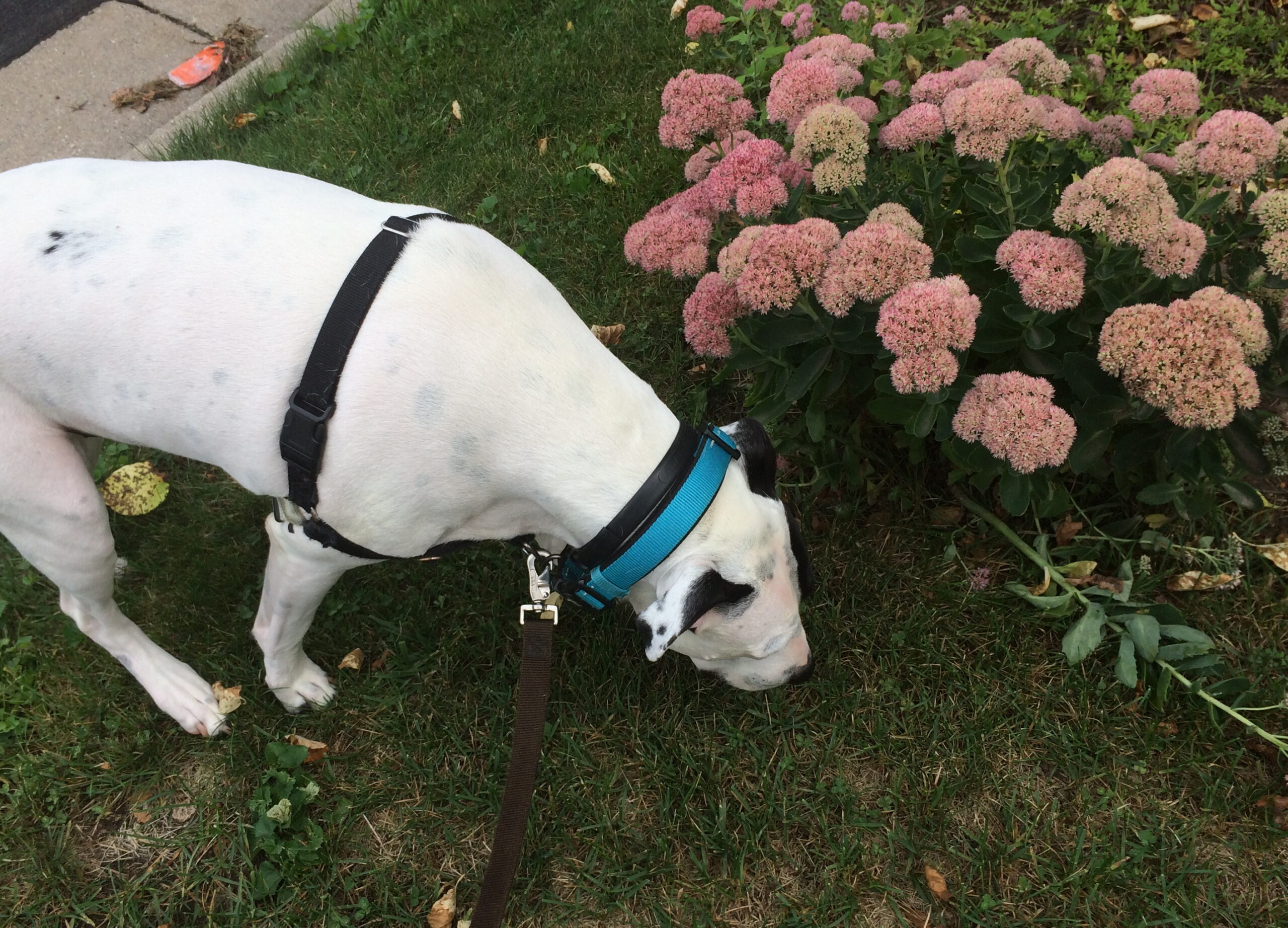
I used the walks as training sessions and worked on keeping Pete in a content emotional state. For management tools I sprayed my clothes with Adaptil ™, placed my music player in a bait bag, and carried a generous supply of Pete’s favorite treats.
During our walks I afforded Pete all the time he required to stop and scan the environment, until he relaxed and wanted to continue walking. He also enjoyed sniffing about and I encouraged him to do so, knowing that activated the seeking system in his brain and promoted the release of dopamine.
I kept his prefrontal cortex engaged with training games along the way, and paid Pete each time he looked up at me. We practiced emergency U-turns when there was nothing in the environment to trouble us, making a game of it. Plan ahead and be prepared.
For the classical/respondent conditioning component I immediately delivered food the instant I became aware of the presence of a dog in the environment. Like so many neighborhoods I work in, Pete has neighboring dogs who are themselves quite reactive and engage in barking episodes when they hear or see another dog approaching. I associated food with the audible or visual stimuli that informed Pete there was a dog in the area, developing a favorable conditioned emotional response.
We typically encountered three or four people who were walking their dogs and because I was in the habit of scanning the environment, I always saw them before Pete did. That gave me the opportunity to engage him in training games, including Find It. The dopamine train kept rolling down the tracks while the other dog passed by, on the opposite side of the street.
At some point Pete would look at the dog, but rather than entering a state of alarm, he watched quietly and then looked back at me. I praised him and paid him each time. Pete’s brain was developing new neural pathways in response to encountered dogs during a walk.
This investment paid dividends a few weeks ago. We were walking down the sidewalk toward an intersection so I slowed down in order to look down the intersecting street. Sure enough, there was a lady walking her dog in our direction. Pete saw the dog and I began working with him.
Then something unexpected happened.
Two houses past the lady I saw a black dog burst out the front door of a house. He shot to the sidewalk, saw the lady and sprinted toward her dog, jumping on it repeatedly. All the while I heard a woman’s voice in the distance shouting “Toby! Toby! Toby come here!” But Toby was not listening, he was too busy mobbing the other dog.
Had that happened to Pete we would have had a true emergency, but we had paused about 200 feet away, calmly made a U-turn and went the other way. Pete walked beside me, looking over his shoulder repeatedly at the fracas behind us.
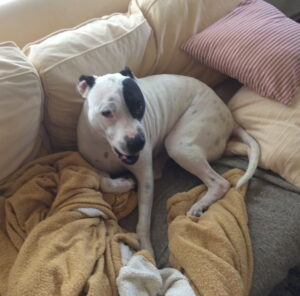
In the six months that I walked Pete, he never went over threshold , and his guardians report the same success during their walks.
Conclusion
Your best bet is to work with a qualified force-free professional. If that is not an option, there are good resources to help you, and please remember how Ranger, Rocket and Pete succeeded. They are just three of many reactive dogs that I have watched blossom.
Best Wishes!
Photo Credits: Daniel H. Antolec ©
References:
Ziv, G. (2017) The effects of using aversive training methods in dogs – a review. Journal of Veterinary Behaviour, 19:50-60 Source: https://www.sciencedirect.com/science/article/abs/pii/S1558787817300357
Books:
Arthur, Nan Kene (2009) Chill Out Fido! How to Calm Your Dog. Dogwise Publishing.
Brown, Ali M.Ed., CPDT ((2009) Scaredy Dog! Understanding and Rehabilitating Your Reactive Dog (Revised Edition). Tanacacia Press.
Jacobs, Debbie (CPDT-KA (2011) A Guide to Living With & Training a Fearful Dog. Dogwise Publishing.
McConnell, Patricia Ph.D, CAAB (1998) The Cautious Canine-How to Help Dogs Conquer Their Fears (2nd Edition). PMcC.
Moeller, Kim (2009) Reactive Rover: An Owner’s Guide to on Leash Dog Aggression. Kim Moeller Publishing.
Wilde, Nicole CPDT-KA (2006) Help for Your Fearful Dog: A Step-by-Step Guide to Helping Your Dog Conquer His Fears. Phantom Publishing.
DVDs:
Flynn, Tristan CPDT-KA, CDBC (2016) The Leash Reactivity Blueprint. Tawzerdog.
Kalnajs, Sarah (2007) The Language of Dogs: Understanding Canine Body Language and other Communication Signals. Blue Dog Training & Behavior LLC.
Larlham, Emily (2013) Reactivity: A Program for Rehabilitation. Tawzerdog.
McConnell, Patricia B. Ph.D. (2010) Treating Dog-Dog Reactivity. PMcC.
Rugaas, Turid. Calming Signals: What Your Dog Tells You. Dogwise DVD.
Wilde, Nichole CPDT (2006) Working With Fearful Dogs Seminar Video: A Step-by-Step Guide to Helping Your Dog Conquer His Fears. Tawzerdog
Yin, Dr. Sophia (2013) Solving Fear and Aggression: Help Your Dog Achieve His Potential. Tawzerdog.

